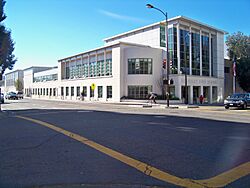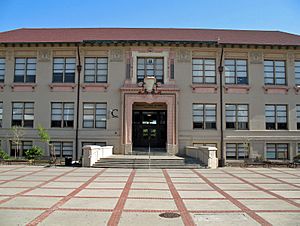Berkeley High School (California) facts for kids
Quick facts for kids Berkeley High School |
|
|---|---|
 |
|
 |
|
| Address | |
|
1980 Allston Way
, 94704
|
|
| Coordinates | 37°52′04″N 122°16′17″W / 37.86772°N 122.27141°W |
| Information | |
| School type | Public high school |
| Established | 1880 |
| School district | Berkeley Unified School District |
| NCES District ID | 0604740 |
| NCES School ID | 060474000432 |
| Principal | Juan Raygoza |
| Teaching staff | 162.37 (FTE) |
| Grades | 9-12 |
| Enrollment | 3,154 (2018–19) |
| Student to teacher ratio | 19.42 |
| Hours in school day | 7 |
| Campus type | Urban |
| Color(s) | Red and gold |
| Athletics conference | West Alameda County (WAC) |
| Nickname | Yellowjackets |
| Accreditation | Western Association of Schools and Colleges (WASC) |
| Newspaper | Berkeley High Jacket |
| Yearbook | Olla Podrida |
| Feeder schools | King Middle School Willard Middle School Longfellow Middle School |
| Website | Berkeley High School |
Berkeley High School is a public high school in the Berkeley Unified School District, and the only public high school in the city of Berkeley, California, United States. It is located one long block west of Shattuck Avenue and three short blocks south of University Avenue in Downtown Berkeley. The school mascot is the Yellowjacket.
Some of the campus buildings are recognized as a Berkeley Landmark by the city; and since January 7, 2008 eight of the campus buildings were designated a historic district by the National Register of Historic Places under the name, the Berkeley High School Campus Historic District.
History

The first public high school classes in Berkeley were held at the Kellogg Primary School located at Oxford and Center streets adjacent to the campus of the University of California. It opened in 1880 and the first high school graduation occurred in 1884. In 1895, the first high school annual was published, entitled the Crimson and Gold (changed to Olla Podrida by 1899).
In 1900, the citizens of Berkeley voted in favor of a bond measure to establish the first dedicated public high school campus in the city. In 1901, construction began on the northwest portion of the present site of the high school. The main school building stood on the corner of Grove (now Martin Luther King Way) and Allston Way, where the "H" building is located today. At that time, Kittredge Street ran through what is today's campus site instead of ending at Milvia. The local office of the Bay Cities Telephone Company sat on the site of today's administration building at the corner of Allston Way and Milvia by 1911.
On Arbor Day of 1902, noted naturalist John Muir joined Berkeley's mayor William H. Marston in planting a giant sequoia in a yard south of the new high school buildings. The tree is apparently no longer there, pending results from a future investigation.
The main building of the high school suffered moderate damage in the form of toppled chimneys, broken windows and some weakened walls as a result of the 1906 San Francisco earthquake. Professor Andrew Lawson of the University of California included one of his own photographs (shown at left) of the damage in his famous report issued in 1908. The building was subsequently repaired and re-opened. In 1934, it was demolished and soon thereafter replaced by the buildings that stand there now, the "H" and "G" buildings.
In 1955, Berkeley High School band director Bob Lutt (who eventually was made executive director of the Berkeley Symphony Orchestra), founded Cazadero Performing Arts Camp.
In 1964, the West Campus of Berkeley High School was opened in the buildings of the former Burbank Junior High School at Bonar Street and University Avenue. It served all ninth graders, while the main campus served grades 10–12, except for an interval from the mid-1970s to the early 1980s when it was 7–9 to accommodate construction at Willard Junior High School. It was turned over to the Berkeley Adult School in 1986, which used it until 2004. West Campus is currently closed, but the main building is being used as the administrative offices of the Berkeley Unified School District.
A number of famous performers have played at the Berkeley Community Theater on the Berkeley High campus. On May 23, 1952, Paul Robeson sang, despite a small McCarthy-era furor. In 1957, Stan Getz was one of the featured performers of the Berkeley Jazz Festival.
A significant portion of students and faculty alike were involved with the various forms of political activism which characterized the sixties in Berkeley, including protests against the Vietnam War, advocacy for civil rights and third world studies, and supporting People's Park. The campus included a Black Students Union, Chicano Student Union, and Asian Student Union (formerly called the Oriental Student Union). In 1971, Berkeley High students elected a homosexual male African American student as Homecoming Queen.
Berkeley High School has been innovative in its high school curriculum. In the fall of 1970, a "school within a school" opened at Berkeley High, called Community High School. It was "alternative", in keeping with the sixties culture which permeated life in Berkeley at the time. By 1974, there were several small schools within Berkeley High: Genesis-Agora (formerly Community and Community 2), Model School A, School of the Arts, and College Prep. Berkeley High School was also the first public high school in the United States with an African American Studies department, established in 1969.
The campus was designated a historic district, the Berkeley High School Campus Historic District, by the National Register of Historic Places on January 7, 2008.
Administration and organization
Demographics
Berkeley High demographics, as of the 2017–2018 school year, out of 3,118 enrolled students:
- 463 (15%) African American or Black
- 7 (0.2%) American Indian or Alaska Native
- 251 (8%) Asian
- 22 (0.7%) Filipino
- 731 (23%) Hispanic or Latino
- 11 (0.3%) Pacific Islander or Native Hawaiian
- 1,258 (40%) White, non-Hispanic
- 375 (12%) identifying as two or more races
- 949 (30%) received free/reduced meal, English learners or foster youth
- 884 (28%) received free and reduced price meals
- 177 (6%) English learners
- 652 (21%) fluent English proficient
Achievement gap
The achievement gap refers to the academic disparity between certain groups, including African-Americans, Latinos, students whose first language is not English, and students living in poverty, that perform significantly below others. This gap extends beyond the results of standardized test scores and also applies to the disparity between certain groups regarding dropout rates, participation in honors classes and Advanced Placement (AP) exams, and numbers of students admitted to colleges. Due to Berkeley High School's racially, ethnically and socio-economically diverse student population, it has been called the "most integrated high school in America." However an achievement gap continues to exist between the white students and black and Latino students. For example, for the 2017–18 school year, the percentages of white students who graduated with the requirements for the UC application fulfilled was 86%, compared to 40% of black students and 50% of Latino students. In 2015, the graduation rate for English learners was 68%--much lower than any other group. Beyond academics and looking at student performance and behavior, "white and hispanic students are suspended less frequently than African-American students," and black students are much more frequently expelled, drop out, are absent, and/or are enrolled in remedial classes and special education. Regarding post-graduation, "many white and Asian students graduate with honors and attend elite colleges and universities, while few blacks and Latino students follow a similar path."
Small schools
In 2000, in an attempt to better serve its diverse community and close the achievement gap between white students and students of color, BHS began experimenting with the idea of small schools. In 2005, Berkeley High School officially established four small schools and a comprehensive program, Academic Choice.
The small schools that began the 2005-06 school with 240 students were
- The Arts and Humanities Academy (AHA)
- Communication Arts and Sciences (CAS)
- Academy of Medicine and Public Service (AMPS)
In addition to the smaller schools, there are two Comprehensive Learning Communities which compose nearly two-thirds of the student body, between 1000 and 1300 students. Academic Choice (AC) and Berkeley International High School (BIHS) - part of the International Baccalaureate (IB) program as of 2007[update] - make up this Comprehensive Learning Community.
- Academic Choice (AC)
- Berkeley International High School (BIHS)
Prior to the Fall 2018 school year, upon enrolling at Berkeley High School incoming freshmen immediately chose to join one of the five learning communities that vary in size, academic emphasis and offerings. Taking into account these preferences as well as a student's zip code, a lottery system determined the student's placement in one of the small schools. However, after several years, it was clear that the learning communities model had made little progress in closing the academic achievement gap between students at BHS. A demographic breakdown of small schools from the Western Association of Schools and Colleges (WASC) Report from 2011 to 2012 reported that within AC was 12% Latino students, 19% African American students, and 41% white, and within IB was 11% Latino, 29% African American and 47% white; while within AMPS was 24% Latino, 51% African American and 9% white. Moreover, Green Academy (now discontinued) and AMPS were the learning communities with the most students who scored not proficient in Math and English California Standards Test (CST) scores.
Demographics and Math/English proficiency rates by learning community
The following demographics data was disaggregated by learning community by the BUSD WASC Self-Study of 2011–2012. Note that Green Academy and Life Academy have been discontinued.
BHS Demographics 2010-2011
| Small school | Native/Asian/Pacific | Latino | African American | White | Multi | Unknown | Total |
|---|---|---|---|---|---|---|---|
| Academic Choice (AC) | 13% | 12% | 19% | 41% | 11% | 4% | 1336 |
| Arts and Humanities Academy (AHA) | 8% | 14% | 30% | 36% | 10% | 1% | 236 |
| Berkeley International High School (BIHS) | 9% | 11% | 20% | 47% | 11% | 2% | 918 |
| Communications Arts & Sciences (CAS) | 5% | 19% | 34% | 27% | 13% | 1% | 231 |
| Medicine and Public Service (AMPS) | 6% | 24% | 51% | 9% | 7% | 3% | 238 |
| Green Academy (discontinued) | 10% | 12% | 44% | 20% | 11% | 3% | 261 |
| Life Academy (discontinued) | 0% | 14% | 62% | 5% | 19% | 0% | 21 |
| All of BHS | 10% | 13% | 26% | 37% | 11% | 3% | 3241 |
| Independent Study Program | 9% | 9% | 33% | 38% | 11% | 159 |
The following California Standards Test (CST) data was disaggregated by learning community by the BUSD Department of Evaluation and compares the proficiency rates of Berkeley High School's six learning communities. Note that Green Academy has been discontinued.
Percent of students "proficient or above" in Math and English California Standards Test (CST) scores
| Small school | Enrollment 2011 | English 2007 | English 2011 | Math 2007 | Math 2011 |
|---|---|---|---|---|---|
| Academic Choice (AC) | 1,300 | 67% | 57% | 36% | 30% |
| Berkeley International High School (BIHS) | 900 | 64% | 69% | 39% | 33% |
| Arts and Humanities (AHA) | 240 | 40% | 47% | 12% | 7% |
| Communication Arts & Sciences (CAS) | 240 | 42% | 31% | 5% | 6% |
| Medicine & Public Service (AMPS) | 240 | 28% | 22% | 4% | 2% |
| Green Academy (now discontinued) | 280 | 36% | 30% | 7% | 6% |
| Berkeley High School average | 3,200 | 51% | 52% | 24% | 23% |
| California state average | 41% | 49% | 21% | 28% |
Possible achievement gap explanations
A policy exists surrounding students who wish to be placed in IB or AC (the most rigorous of the small schools) that guarantees them a spot in one of those small schools if they don't list any other choices. "The majority of white students and Asian students who come into school don't choose the small learning communities, they only choose IB or AC" and this policy hasn't been removed because parents have fought against students having to be placed in a small learning community if they did not want them to. Segregation among students is another possible explanation for the persistence of the achievement gap. A BHS teacher said that "freshmen often will decide their learning community based on stereotypes within the school." "Much of the segregation occurs during the nonstructural part of the school day: before and after school, during lunch and between classes." Segregation inside schools is directly influenced by segregation outside of school, and in Berkeley white students are more reported to be from middle and upper-middle-class families living the Berkeley hills while minority students are more reported to come from lower income families in the more flatland neighborhoods.
Universal 9th Grade
In 2015, administrators began discussions about reorganizing the high school. The Berkeley Redesign Project involved teachers, staff, students and parents. The first major change was to switch to a "universal 9th grade," in which freshmen will be placed in core groups of 120 students, with the choice of learning community beginning in tenth grade. This is intended to counter the occurrence of freshmen choosing their learning community based on stereotypes within the school and give them the opportunity to learn what the communities are like first-hand before they decide which one to join by creating a "randomized and intentionally heterogenous collection of students who would share a core group of teachers" that monitor the students and make sure none slip through the cracks. Originally slated to start in the fall of 2017, the program began in the fall of 2018. These core groups, called hives, are composed of about 120 students who share 4 teachers in their core subject areas: Math 1 (or Advanced Math 1), Physics 1, English, and Ethnic Studies/Social Living. Students also get to choose two electives. "At the end of ninth grade, students then have the opportunity to rank one of the five learning communities at Berkeley High School for their 10th-12th grade education." After the BHS lottery process and upon being placed into a learning community, students are required to fulfill each learning community's unique academic requirements and are able to choose additional courses from individual departments, like African American Studies, Math, Performing and Visual Arts, Physical Education, Science and World Language. If students prefer a more flexible and individualized education, they have the option of Berkeley Independent Study (BIS) as an alternative to the traditional classroom environment.
Potential future changes
More ideas addressing the achievement gap include implementing an additional period strictly for advising so as to provide not just academic support and guidance with course selection, but social and emotional support as well—especially with regards post-graduation plans. One worry, however, is the fact that because academic disparities among racial and socioeconomic groups are established in elementary and middle school, these programs aimed at closing the achievement gap at BHS won't make that much of a difference. The argument is then made for elementary and middle schools to make similar efforts in order to reduce those disparities more early on. To add, the development of interactive feedback loops would give districts the potential to continuously measure effectiveness and then implement alterations or modifications to its programs. A 5-year reform by the Bay Area School Reform Collaborative (BASRC) stresses the importance of adequate professional development for teachers to ensure they are fully prepared to implement school-wide programs for positive change, including teachers being treated as active learners through trainings and workshops and being empowered as professionals by each other and teacher educators.
Independent ratings
Berkeley High School has been rated by several independent organizations. It currently receives a rating of 8/10 by GreatSchools, which utilizes test score, college readiness, course offering, equity, and discipline data to evaluate schools. It receives a grade of A+ by Niche, which utilizes public data and user reviews.
Departments, parent and student organizations
- African American Studies Department
- Academic Choice Advisory Council
- Athletics: basketball, badminton, crew, cross country, football, women's lacrosse, men's lacrosse, track and field
- BHS Athletic Fund
- Computer Technology
- ESL/ELL
- English and World Language
- History
- JSA
- Mathematics
- Journalism, which produces the locally prominent school newspaper, the Berkeley High Jacket
- Physical Education
- PTSA
- Science
- Special Education
- Visual and Performing Arts: Jazz Ensemble
- Youth & Government
Campus and architecture
The Berkeley High School campus covers four city blocks between Milvia Street and Martin Luther King Jr. Way, and Allston and Channing Ways. The first cornerstone was laid in 1901, and the complex has been under almost continuous construction ever since, except for a decade around World War II. In the late 1930s, Berkeley High was remodeled and old buildings were replaced with newer ones. The Florence Schwimley Little Theater, the Berkeley Community Theatre, and the G and H buildings are prime examples of the Streamline Moderne style designed by architects Henry H. Gutterson and William G. Corlett. The rebuilding was financed largely through Franklin Roosevelt's New Deal program the WPA. They are embellished with sculptural reliefs by Robert Boardman Howard, Jacques Schnier and Lulu Hawkins Braghetta.
Notable people
See also


